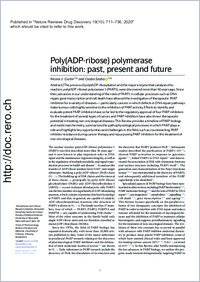Poly(ADP-ribose) polymerase inhibition: past, present and future
- Curtin, Nicola J. Translational and Clinical Research Institute, Newcastle University Centre for Cancer, Faculty of Medical Sciences, University of Newcastle, Newcastle upon Tyne, UK
- Szabo, Csaba Chair of Pharmacology, Section of Science and Medicine, University of Fribourg, Fribourg, Switzerland
-
03.09.2020
Published in:
- Nature Reviews Drug Discovery. - 2020, vol. 19, no. 10, p. 711–736
English
The process of poly(ADP-ribosyl)ation and the major enzyme that catalyses this reaction, poly(ADP-ribose) polymerase 1 (PARP1), were discovered more than 50 years ago. Since then, advances in our understanding of the roles of PARP1 in cellular processes such as DNA repair, gene transcription and cell death have allowed the investigation of therapeutic PARP inhibition for a variety of diseases — particularly cancers in which defects in DNA repair pathways make tumour cells highly sensitive to the inhibition of PARP activity. Efforts to identify and evaluate potent PARP inhibitors have so far led to the regulatory approval of four PARP inhibitors for the treatment of several types of cancer, and PARP inhibitors have also shown therapeutic potential in treating non-oncological diseases. This Review provides a timeline of PARP biology and medicinal chemistry, summarizes the pathophysiological processes in which PARP plays a role and highlights key opportunities and challenges in the field, such as counteracting PARP inhibitor resistance during cancer therapy and repurposing PARP inhibitors for the treatment of non-oncological diseases.
- Faculty
- Faculté des sciences et de médecine
- Department
- Médecine 3ème année
- Language
-
- English
- Classification
- Biological sciences
- License
-
License undefined
- Identifiers
-
- RERO DOC 329418
- DOI 10.1038/s41573-020-0076-6
- Persistent URL
- https://folia.unifr.ch/unifr/documents/308962
Statistics
Document views: 125
File downloads:
- pdf: 1320
